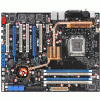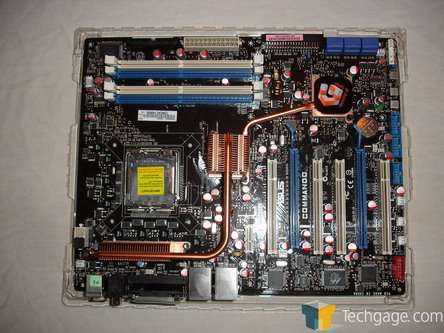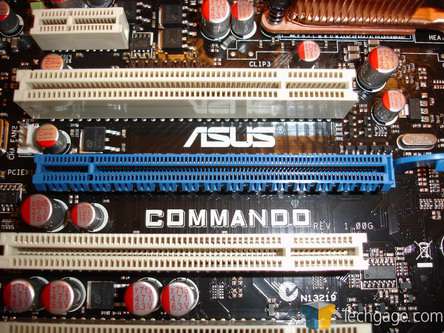- Qualcomm Launches Snapdragon 4 Gen 2 Mobile Platform
- AMD Launches Ryzen PRO 7000 Series Mobile & Desktop Platform
- Intel Launches Sleek Single-Slot Arc Pro A60 Workstation Graphics Card
- NVIDIA Announces Latest Ada Lovelace Additions: GeForce RTX 4060 Ti & RTX 4060
- Maxon Redshift With AMD Radeon GPU Rendering Support Now Available
ASUS Commando

ASUS has been on a roll with their RoG line of motherboards. Their third installment, Commando, looks to impress enthusiasts with the help of Intels P965 chipset. How does this board stack up against others, and is it worthy of the Republic of Gamers name?
Page 8 – Overclocking with the Commando
|
|
When we get into the overclocking results in any review, be it CPU, RAM, or GPU, the results are somewhat of a sticky issue to report on. The old saying that your mileage may vary cannot be overused. Overclocking results basically come down to two things. First is your experience in working with the hardware you have. In doing so, you’re past experiences and knowledge of each and every BIOS setting comes into play. To tweak the absolute maximum out of your hardware, a lot of time and effort has to be put into your work and sometimes then, there will be others who trump your highest clocks.
The second part of overclocking is the hardware itself. No two motherboards, processors, video cards and memory are the same. It could be that you have read a report of someone’s success with a certain set of hardware and think that by buying that exact setup, you will get the same results. This is a frustrating reality in overclocking… nothing is guaranteed.
What we are trying to say is that we hope that no one reading our reviews will take our findings and accept them as the de-facto maximum results capable by that hardware. I know personally that I am an average overclocker. I am not great, but I do understand a majority of what the settings do. For everyone of me, there is a hundred people better at overclocking and I understand that. If you look around the net, you will find many sites obtained better results and that’s fine. That’s just the gauntlet that we run when we bench. With that said, let’s get into our findings.
One of the most heralded features of the P965 chipset is its ability to produce incredible overclocks. In working with the Commando, this rumor was proven as fact. While not as high as others have gotten to, the performance of the board, even with everything in BIOS set to AUTO. I was able to quite easily get the FSB up to 406 MHz with everything set in the BIOS as AUTO. Once the CPU multiplier was dropped however, as we continue on our AUTO settings rampage through the BIOS, we eventually settled at an impressive 432 MHz FSB. Again, this was with everything set to AUTO. This includes memory timings, voltage settings… everything.
In an attempt to find the highest, stable front side bus frequency, we again lowered the E6600’s multiplier to 6, but instead of leaving everything as AUTO in the BIOS, we started to mess with the memory timings and voltage settings. The RAM being used is the same Kingston set that Rob reviewed a few weeks ago. In the review, Rob was able to push the RAM up to 621 MHz and at that frequency; the RAM should not be the limiting factor in our attempts. After loosening the timings quite a bit to 5-5-5-15, upping the voltage to the RAM to 2.35v and the northbridge voltage to 1.475v, we were able to push the board to an even more impressive 475MHz. For many users of the Commando, this is the norm. For me however, this frequency was a wall that we just couldn’t seem to get over. Even with speeds that high, it’s still 95MHz lower than the claimed 570MHz that Asus has achieved. As stated earlier, overclocking is the consummate example of the saying “mileage may vary.”
You may have noticed the CrossFire setup in one of the above pictures. I am disappointed to report that the picture was as far as we got with CrossFire on the Commando. Once we loaded any 3D games, the screen would flicker at a slow, deliberate pace. This was not corrected when different drivers were used, Windows was reinstalled, cards were switched in the slots, the BIOS was updated and holy water was sprinkled around the bench. We even switched out the power supply. During testing, we were using the Enermax Galaxy 850W power supply, which should have been overkill for that system but while CrossFire worked perfectly on the two DFI motherboards, we thought that it might help to switch out the power supply. We then went with an Ultra 800W but the problem persisted.
In a single GPU setup, things are quite different. In almost all of the benchmarks, the Commando bested the value offering from DFI and its bigger, more expensive brother, the ICFX3200. We were never able to figure out what was causing the problems with CrossFire but it very well might be related to the chipset. P965 was originally designed not to allow the user to run a pair of GPUs in parallel and while we have proof that others have not had this problem, this was something that we could not figure out. With that said, the performance of the Commando using a single GPU was superb.
As far as stability is concerned, the Commando, in typical Asus style, was as stable as a rock. After approximately 24 hours of stress testing, the Commando was still looping away. This is above all, a testament to the time and effort that the engineers at Asus put into their products.
In Windows Vista, our experiences were similar to those using XP Pro. The response of the OS on our test bed was quick and we ran into zero problems. Earlier we mentioned that the Commando comes with a driver disk just for Vista. After Windows Vista loaded, we checked in the device manager to see what hardware still needed to be installed. To our surprise, Windows recognized everything that the disk was not needed. Working with the stock Windows drivers was smooth and after a few rounds of GRAW, we have no problems recommending this motherboard for anyone building a Vista PC.
All in all, the performance of the Commando speaks for itself. The single GPU scores are strong and while we did have our problems with CrossFire, the overall experience as a whole was a positive one. Having said that though, with the Commando bearing the markings of a Republic of Gamers product is the Commando really suitable to wear that badge? Our answer is a pretty ambiguous one at best. Our stance on it is yes… and no. On one hand, gamers deserve the very best if the product is specifically marketed towards that one group. Gamers, being early adopters of everything as well as wanting the best performance that they can afford, are more likely to be the ones running a dual GPU setup. This just so happens to be the Commando’s Achilles heel.
To counter that argument though, how many people actually own a pair of video cards? By taking a quick look at Valve’s steampowered hardware survey results, out of 1,165,194 unique samples, only 16,931 use a multi-GPU setup. This is either because you don’t exactly need to have a pair of GPUs to run Half Life 2 anymore or more realistically, people choose to spend their money elsewhere. So when saying that 1.45% of the total participants of the Steam survey use multi-GPUs kind of puts the CrossFire issues into perspective. And I know that their survey doesn’t speak for the entire gaming community but realistically, almost everyone I know runs Steam. Everyone loves the Half Life series and finally, where else is anyone to get the broad stats that are offered at Valve’s site?
For those that don’t need a CrossFire motherboard, I 100% stand behind the Asus Commando. It’s stable and it performs exceptionally well. The layout of the board is clean and well thought out. When installed in a case, the lights from the buttons, along with the black PCB and copper heatsinks and pipes are just dead sexy. For those of you looking for a solid motherboard, the Commando should be near the top of your list. For those of you who do not need an LCD display on your I/O panel, or just cant justify dropping $200 on a motherboard, you might want to look towards the popular P5B line of motherboards from Asus. For those that want an exclusive motherboard and want to show it off, the Commando is certainly for you.
Taking everything into consideration, the Commando gets an 8 out of 10.
-
Pros
- Clean, all black PCB
- It’s a Republic of Gamers board
- LCD display on the back is a neat novelty
- On board power, reset and clear CMOS buttons
- 100% rock solid stable
- Overclocks well, even at default settings
- Ships with Ghost Recon: Advanced Warfighter
- Completely stable foundation for Windows Vista
-
Cons
- When CrossFire works, it’s still crippled by a x4 PCI-E slot
- Expensive
If you have a comment you wish to make on this review, feel free to head on into our forums! There is no need to register in order to reply to such threads.

|
|
Support our efforts! With ad revenue at an all-time low for written websites, we're relying more than ever on reader support to help us continue putting so much effort into this type of content. You can support us by becoming a Patron, or by using our Amazon shopping affiliate links listed through our articles. Thanks for your support!






